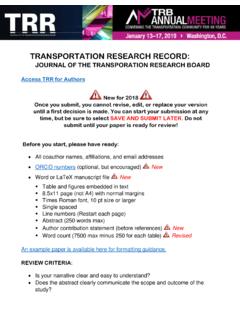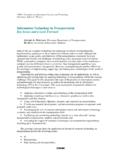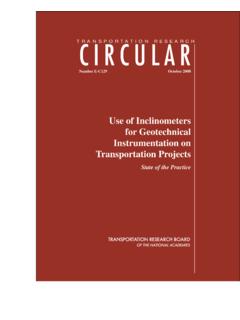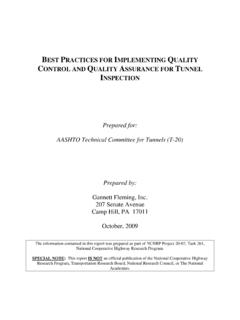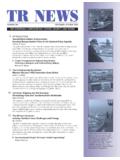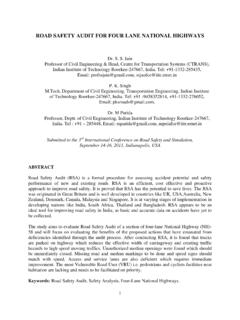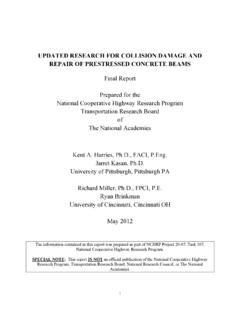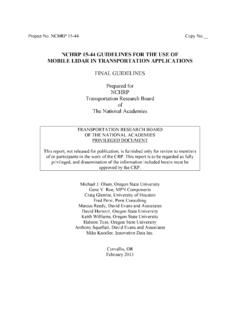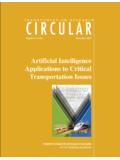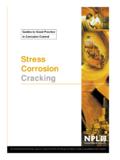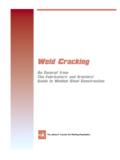Transcription of Appendix A Pavement Distress Types and Causes
1 Appendix APavement Distress Types and CausesThis Appendix provides descriptions of the Types and Causes of the distresses that occur inasphalt, concrete, and asphalt-overlaid concrete pavements, and asphalt and concreteshoulders. Many of the photos used in this Appendix are from the LTPPD istress Pavement DistressesFatigue (Alligator) CrackingFatigue (also called alligator) cracking , which is caused by fatigue damage, is the principalstructural Distress which occurs in asphalt pavements with granular and weakly stabilizedbases. Alligator cracking first appears as parallel longitudinal cracks in the wheelpaths, andprogresses into a network of interconnecting cracks resembling chicken wire or the skin of analligator.
2 Alligator cracking may progress further, particularly in areas where the support isweakest, to localized failures and A-1. Fatigue (alligator) cracking in asphalt which influence the development of alligator cracking are the number and magnitude ofapplied loads, the structural design of the Pavement (layer materials and thicknesses), thequality and uniformity of foundation support, the consistency of the asphalt cement, the asphaltcontent, the air voids and aggregate characeristics of the asphalt concrete mix, and the climateof the site ( , the seasonal range and distribution of temperatures). 2,3A - 1 Considerable laboratory research into the fatigue life of asphalt concrete mixes has beenconducted.
3 However, attempting to infer from such laboratory tests how asphalt concrete mixproperties influence asphalt Pavement fatigue life requires consideration of the mode oflaboratory testing (constant stress or constant strain) and the failure criterion used. Constant-stress testing suggests that any asphalt cement property ( , lower penetration, higherviscosity) or mix property which increases mix stiffness will increase fatigue life. Constant-straintesting suggests the opposite: that less brittle mixes ( , higher penetrations, lower viscosities)exhibit longer fatigue lives. The prevailing recommendations are that low-stiffness (low viscosity)asphalt cements should be used for thin asphalt concrete layers ( , less than 5 inches), andthat the fatigue life of such mixes should be evaluated using constant-strain testing, while high-stiffness (high viscosity)
4 Asphalt cements should be used for asphalt concrete layers 5 inches and thicker, and the fatigue life of such mixes should be evaluated using practice, however, it is not common to modify the mixture stiffness for differentasphalt concrete layer is the accumulation of asphalt cement material at the Pavement surface, beginning asindividual drops which eventually coalesce into a shiny, sticky film. Bleeding is theconsequence of a mix deficiency: an asphalt cement content in excess of that which the airvoids in the mix can accommodate at higher temperatures (when the asphalt cement expands).
5 Bleeding occurs in hot weather but is not reversed in cold weather, so it results in anaccumulation of excess asphalt cement on the Pavement surface. Bleeding reduces surfacefriction and is therefore a potential safety A-2. Tire marks evident in high-severity bleeding. 1 A - 2 Block cracking and Thermal CrackingBlock cracking is the cracking of an asphalt Pavement into rectangular pieces ranging fromabout 1 ft to 10 ft on a side. Block cracking occurs over large paved areas such as parking lots,as well as roadways, primarily in areas not subjected to traffic loads, but sometimes also inloaded cracks typically develop transversely across the traffic lanes of aroadway, sometimes at such regularly spaced intervals that they may be mistaken for reflectioncracks from an underlying concrete Pavement or stabilized A-3.
6 Medium-severity block cracking . 1 Block cracking and thermal cracking are both related to the use of an asphalt cement which is orhas become too stiff for the climate. Both Types of cracking are caused by shrinkage of theasphalt concrete in response to low temperatures, and progress from the surface of thepavement downward. The key to minimizing block and thermal cracking is using an asphaltcement of sufficiently low stiffness (high penetration), which is nonetheless not overlytemperature-susceptible ( , likely to become extremely stiff at low temperatures regardless ofits penetration index at higher temperatures).
7 Bumps, Settlements and Heaves Bumps, settlements, and heaves in asphalt pavements may be due to frost heave, swelling orcollapsing soil, or localized consolidation (such as that which occurs in poorly compactedbackfill material at culverts and bridge approaches). Frost heave, soil swelling, and soilcollapsing produce longer-wavelength surface distortions than localized - 3 Frost heave occurs in frost-susceptible soils, when sufficient water is available, in freezingclimates such as the northern half of the United States. Water collects in a Pavement ssubgrade by upward capillary movement from the water table and also by condensation.
8 Whenthe temperature in the soil drops below freezing, this water freezes and forms ice lenses, whichmay be up to 18 inches thick. It is the continued and progressive growth of these ice lenses asadditional water is drawn to the freezing front that produces the dramatic raising of the roadsurface known as frost Very fine sands and silts are most susceptible to frost heavebecause of their ability to draw water to considerable heights ( , 20 ft) above the water also have considerable suction potential and are also susceptible to frost heave if theirplasticity index is less than about 10 to 12. Lower permeabilities inhibit the formation of icelenses.
9 Clean sands and gravels and mixed-grain soils with less than 3 percent materialsmaller than mm are not susceptible to frost soils are those clays and shales which are susceptible to experiencing significantvolume increases when sufficient moisture is available to increase the ratio of voids (air andwater) to solids, especially in the absence of an overburden pressure. Overburden pressuremay be reduced when underlying material is excavated, and replaced by a Pavement . If themoisture content of these soils is normally low ( , in a dry climate), and evaporation ofmoisture from the soil is hindered by the presence of the Pavement , considerable swelling mayresult.
10 Swelling soils are responsible for Pavement heaving, poor ride quality, and cracking inmany areas of the southern and western United soils are those soils which are susceptible to experiencing significant volumedecreases when their moisture content increases significantly, even without an increase insurface Soils which are susceptible to collapsing include loessial soils, weakly cementedsands and silts, and certain residual soils. Such materials typically have a loose, open structurein which the larger bulky grains are held together by capillary films, montmorillonite (or otherclay materials), or soluble collapsible soils are associated with dry or semi-aridclimates, while others are commonly found on flood plains and in alluvial fans as the remains ofslope wash and mud CrackingNonwheelpath longitudinal cracking in an asphalt Pavement may reflect up from the edges of an underlying old Pavement or from edges and cracks in a stabilized base, or may be due to poor compaction at the edges of longitudinal paving lanes.
